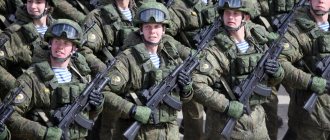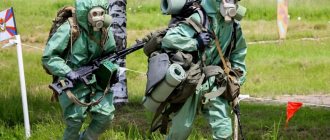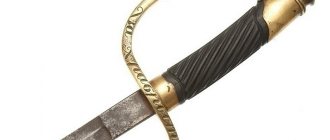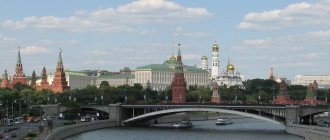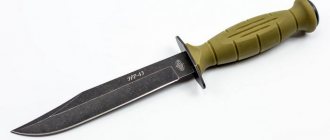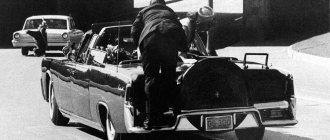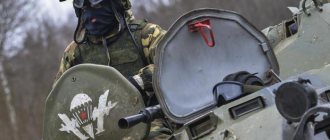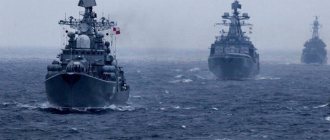Composition and structure of a motorized rifle battalion
In the structure of the Armed Forces of the Russian Federation, this combat unit includes the following subsections:
- Management group
- Battalion headquarters
- Combat units
- Support units
The unit includes both mortar and grenade launcher troops. Their ratio is as follows: 3 motorized rifle companies, mortar battery. Two platoons - anti-tank and grenade launcher. The anti-aircraft missile platoon closes the list.
The provision and maintenance of this army unit is carried out by 2 platoons - communications and support and one medical unit. The command group is created by the commander of a motorized rifle battalion and his two deputies, who are responsible for weapons and personnel. The commander is the highest person in the SME hierarchy. As a rule, the rank of commander is major or lieutenant colonel.
The headquarters is headed by one of the deputy commanders. It also includes the chief of communications, the commander of a platoon of signalmen. A signal platoon consists of several drivers and a radio squad (signalmen, telephone operators, radio technicians, etc.). In total there are 13 people in the communications company.
They provide operation of 8 meters of cable and 22 radio stations. A chemical instructor allows you to conduct drills related to the dangers of chemical attacks. The clerk handles numerous paperwork and assists the commander.
Motorized rifle companies consist of 3 platoons of the same name. Platoons, in turn, are divided into sections. The company has 101 personnel. All battalion personnel vary in number due to several types of SMEs. Thus, battalions working with infantry fighting vehicles in their staff number 462 soldiers, armored personnel carriers - 539.
2.1. Advance of the motorized rifle battalion of the Soviet Army (eighties)
The battalion advances on a front of up to 2 km, and in the breakthrough area on a front of up to 1 km. The battalion can successfully attack a defending enemy infantry company. As a rule, a battalion builds its battle formation in two echelons or in one echelon with the allocation of a combined arms reserve. Typically, two companies operate in the first echelon and one company in the second. A battalion can operate in the first or second echelon of a regiment. A battalion operating in the first echelon of a regiment is assigned an immediate mission (usually to the depth of an enemy infantry company strongpoint), a further mission (usually to the depth of the enemy's first defensive position, and a direction of further attack, which usually coincides with the regiment's immediate mission. A battalion operating in the second echelon The regiment is assigned a line of entry into battle, the immediate task (usually at the depth of the enemy's brigade defense reserves) and the direction of further attack, which usually coincides with the further task of the regiment.
The battalion can advance from a position of direct contact with the enemy. In this case, if the battalion operates in the first echelon of the regiment, then it occupies the initial position at the first position of the regiment, and if the battalion operates in the second echelon of the regiment, then it occupies the initial position at the second position of the regiment.
The battalion can advance on the move (with advancement from the initial area). When advancing on the move, the battalion advancing in the first echelon of the regiment follows on an infantry fighting vehicle in one column to the line of deployment into company columns (4-6 km from the enemy’s front edge), in company columns to the line of deployment into platoon columns (2-3 km from the front the edge of the enemy's defense); at the line of attack (600m from the enemy’s front edge), platoon columns are deployed into battle formation. If necessary, a dismounting line is designated, where the personnel leave the infantry fighting vehicle and then move on foot. If the enemy does not offer fierce resistance, then the offensive continues from the line of transition to the attack of the platoon into the line of vehicles.
When advancing on the move, the battalion advancing in the second echelon of the regiment follows in a battalion column to the line of entry into battle, where it deploys into battle formation.
The battle formation of the advancing battalion is deliberately shown in an extremely simplified manner. It does not show the means and forces of reinforcement, support, assigned forces and means, tanks, artillery, communications equipment and many other mandatory elements of the battalion’s combat order.
Notes:
1. The second echelon is intended to develop the success achieved and increase the tempo of the offensive. He is assigned a line of entry into battle, the immediate and further tasks. 2. The combined arms reserve differs from the second echelon in that it is not assigned a line of entry into battle, as well as immediate and further tasks. It is designed to solve sudden problems (repelling counterattacks of the enemy entering the rear; changing units that have suffered heavy losses, destroying a newly identified enemy, holding captured lines, destroying residual enemy groups in the rear of advancing units.
Military equipment and weapons
The regiment's combat unit, consisting of a company mounted on an infantry fighting vehicle, has the following equipment at its disposal:
- 39 BMP-2 vehicles
- 42 passenger all-terrain vehicles
- "Vasilek" mortars
- mortars with a diameter of 88 mm
- 9 ATGM "Metis"
If a company is equipped with an armored personnel carrier, the composition of military equipment remains virtually unchanged, with the exception that for 539 personnel there are 6 mounted grenade launchers and 44 armored personnel carriers. As for weapons, the fighters receive the following weapons for use: RPG-7 grenades, AK-74 assault rifles. The drivers and field kitchen are armed with pistols.
Number and who is in command
The platoon commander is usually a person with the rank of major or lieutenant colonel. He is assisted in his command by two deputies - for weapons and personnel. In addition, there is a full-fledged headquarters, which is headed by one of the deputies.
Separate from the platoon personnel there is a communications department under the leadership of the squad commander. The communications department has 13 people.
The next largest combat unit within a platoon is a company. The company, equipped with infantry fighting vehicles, numbers 92 people, 11 soldiers in each squad. Those occupied by the armored personnel carrier are in the corresponding company with a total strength of 101 people.
They additionally rely on several machine gunners, as well as a sniper armed with an SVD. True, in recent years snipers have been removed from most motorized rifle companies.
(eighties)
A motorized rifle platoon can conduct a defensive battle, being in the first or second echelon of a company, in the combat outpost of a battalion, or in the forward position of a regiment. A motorized rifle platoon defends a strong point
length along the front up to 400m, and depth up to 300m. When performing a combat guard mission, a platoon can defend up to 500m. along the front. The platoon's battle formation consists of squad positions, which can be located in a line (all squads are located in the first trench), in two lines (the flank squads are located in the first trench, and the central one in the second trench, with a ledge to the right or left (one of the flank squads is located in the second trench, and the other two in the first).
MSV order of battle in line
The length of the squad position is up to 100 m. The distance between squad positions is up to 50 m. and for communication between them the flow of communication is broken off. From the squads located on the flanks of the platoon, communication lines to the left and right neighbors are separated. From the middle squad, the message usually goes to the platoon commander's command post and then to the rear.
For each infantry fighting vehicle, a main and reserve trench are created, with the second trench usually facing the flank or rear, and is designed to provide all-round defense for the platoon. Between the trenches for infantry fighting vehicles the distance is up to 200m. If possible, to ensure all-round defense of the platoon, trenches for squads can be opened, facing the rear and flanks of the platoon's strong point.
The platoon commander's command and observation post is located behind the squad positions at a distance of up to 50m. from the front edge. The KNP is a special form of trench and dugout with a capacity of up to one third of the platoon personnel.
MSV order of battle in two lines
Literature:
Combat regulations of the Ground Forces of the Armed Forces of the USSR (platoon-squad-tank).
The order of battle of a motorized rifle battalion
On defense
Defense can be maneuverable or positional. A motorized rifle battalion conducts defense, usually maneuvering, as part of a brigade. The area of responsibility is assigned no more than 10 km wide and 10 km deep. The order of battle in defense is echelon. Sometimes armored groups or fire ambushes are created with artillery support.
On the offensive
A battalion's advance, as a rule, should be characterized by swiftness and a skillful combination of movement and fire. The battalion is perfectly suited for carrying out fast offensive operations over a wide front. This combat unit has proven itself in attacks against superior enemy forces.
At the outpost
Motorized rifle battalions guarding the territory usually have several additional units. These could be engineer-sapper or chemical squads.
In addition, the battalion creates a reserve deep in the rear of its outpost, so that in case of danger the main forces can be quickly warned of the enemy's advance. All installed firing points must be able to successfully view possible enemy approaches.
COMBAT USE OF GRENADE LAUNCHER AND ANTI-TANK PLATOONS IN THE MAIN TYPES OF COMBAT
1. GRENADE LAUNCHER AND ANTI-TANK SECTION ON THE OFFENSIVE
Grenade launcher squad on the offensive. Automatic mounted grenade launchers as a weapon system for motorized rifle units are designed to destroy enemy personnel and firepower (infantry groups, observation posts, machine gun crews, grenade launchers, guns, mortars, etc.) located outside shelters, in open trenches, trenches, ravines and on reverse slopes of heights at ranges from 300 to 1700 m. The powerful fragmentation effect of a grenade with an area of continuous destruction of enemy personnel with one grenade launcher of 150 m2, and two – 300 m2 made grenade launchers a highly effective fire weapon for motorized rifle units. To calculate the area of a continuous lesion, the radius of scattering of lethal fragments of a grenade is taken, equal to 7 m. The affected area (PC2) with one grenade launcher is equal to 3.14Х7Х Х7м2=150 m2. In combat, the grenade launcher squad uses two types of fire: concentrated and barrage. The squad is capable of placing barrage fire on a front up to 30 m, and with concentrated fire suppressing manpower in an area of 300 m2. The combat formation of a grenade launcher squad, operating on foot, consists of two crews deployed along the front with an interval between grenade launchers of 10–20 m, and an infantry fighting vehicle (armored personnel carrier).
The grenade launcher squad advances behind the battle formations of the first echelon motorized rifle companies at a distance of up to 300 m, in the intervals between them, or on one of the flanks of the battalion and supports the attack of the motorized rifle units. An infantry fighting vehicle (armored personnel carrier), using folds in the terrain, advances from line to line behind its squad at a distance that provides reliable fire support. The grenade launcher squad, during fire preparation for the attack and with the start of the attack with grenade launcher fire from the occupied firing position, destroys and suppresses manpower and fire weapons at the front line of the enemy’s defense. With the destruction of targets or with the approach of motorized rifle units to the line of safe distance from grenade explosions (200 m), the grenade launcher compartment, at the command (signal) of the platoon commander, transfers fire into depth at revived or newly discovered targets. Before the start of the offensive, the grenade launcher squad occupies a firing position, where it opens and equips a trench, and the commander simultaneously prepares the crew for the upcoming battle and issues a combat order, in which he indicates:
— landmarks;
- the composition, position and nature of the enemy’s actions, the outline of the front line of defense and the location of his fire weapons;
— platoon task;
— the task of the department;
— tasks of neighbors;
- crews - targets to be hit, firing positions and the order in which they are occupied, the direction of fire and the order of fire, as well as interaction with motorized rifle units;
- for the gunner-operator (machine gunner) - the procedure for covering the actions of crews and supporting the attack of motorized rifle units with fire from a cannon and machine gun;
- mechanic-driver (driver) - direction of advance, order of movement, overcoming barriers and obstacles;
— warning, control, interaction signals and the procedure for acting on them;
- time of readiness for an offensive and a deputy.
